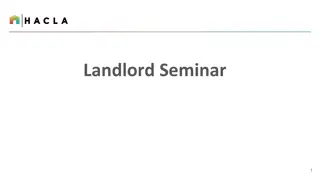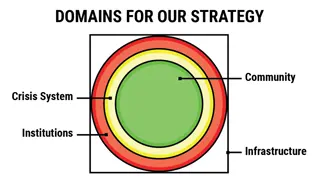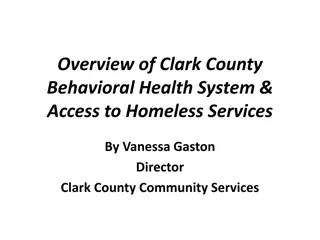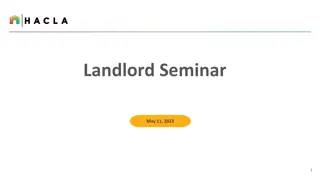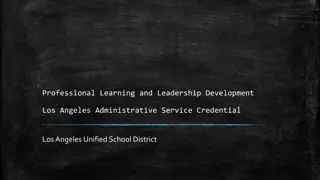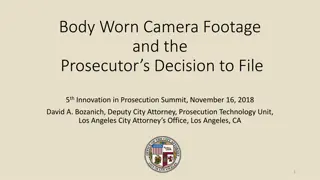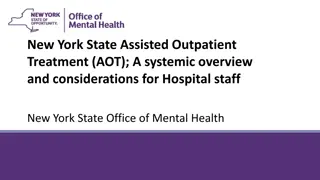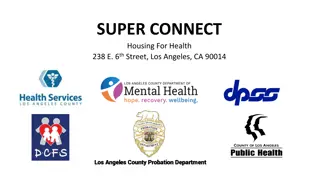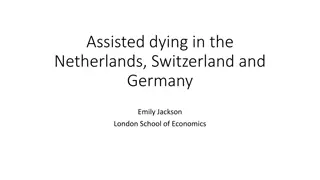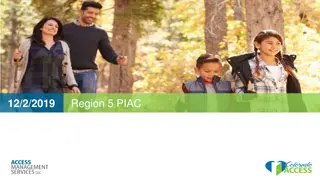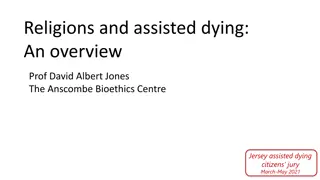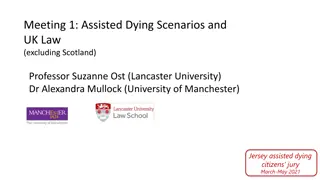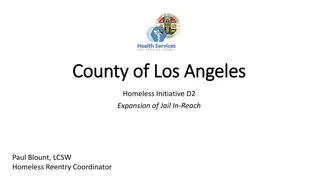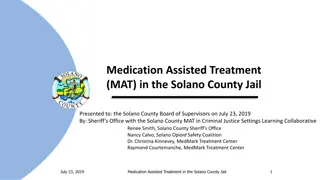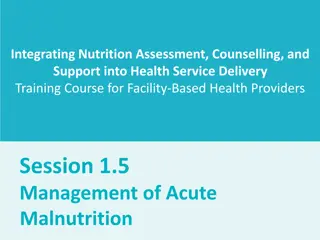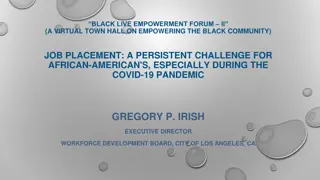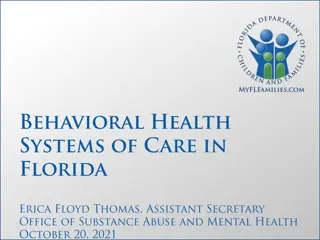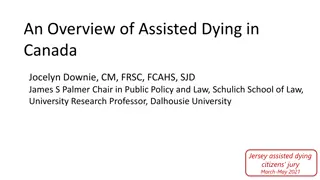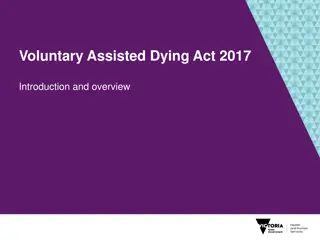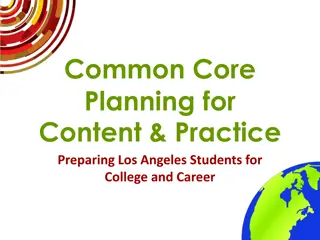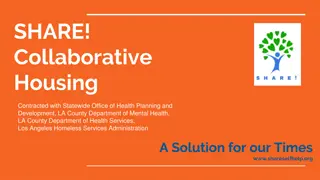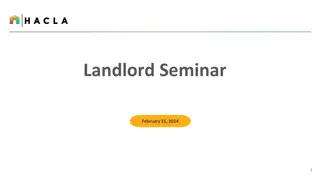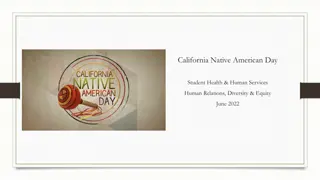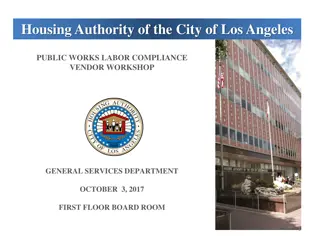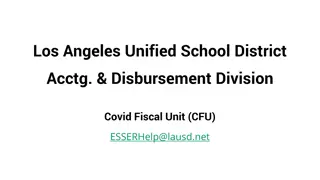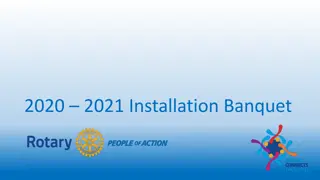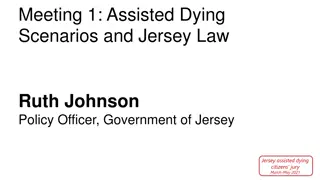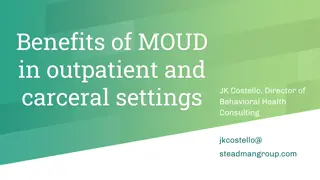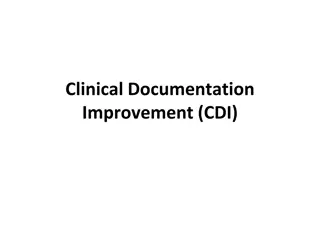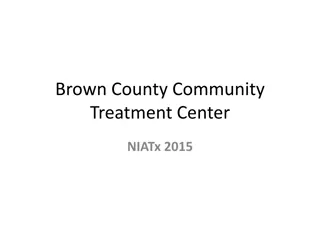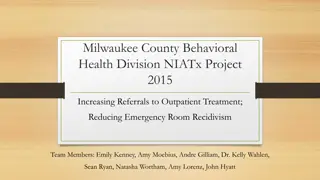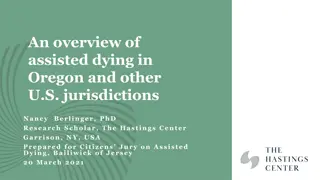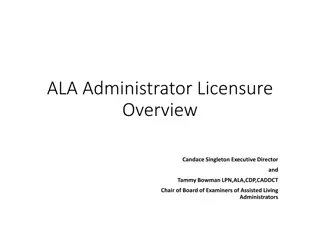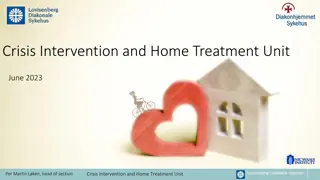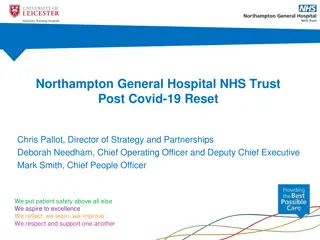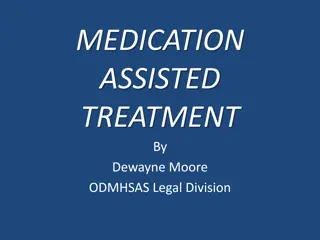Assisted Outpatient Treatment in Los Angeles County: Implications for National Services
The symposium discusses Assisted Outpatient Treatment (AOT) in Los Angeles County, exploring topics such as family involvement, barriers, voluntary vs. involuntary enrollment, violence, and victimization. Presenters highlight the importance of addressing inadequate access to mental health care and poor adherence, emphasizing the need for state policies and federal funding to support involuntary treatment. Studies reveal concerning rates of violence among adults with mental illnesses and the challenges in psychiatric treatment adherence.
- Assisted Outpatient Treatment
- Mental Health Services
- Los Angeles County
- Involuntary Treatment
- Violence
Uploaded on Sep 23, 2024 | 0 Views
Download Presentation

Please find below an Image/Link to download the presentation.
The content on the website is provided AS IS for your information and personal use only. It may not be sold, licensed, or shared on other websites without obtaining consent from the author. Download presentation by click this link. If you encounter any issues during the download, it is possible that the publisher has removed the file from their server.
E N D
Presentation Transcript
Assisted Outpatient Treatment in Los Angeles County: Implications for Involuntary Outpatient Services Nationally 24THNIMH MENTAL HEALTH SERVICES RESEARCH CONFERENCE CHAIR: ERIN KELLY, PH.D. PRESENTERS: SARAH STARKS, PH.D. AND RYAN DOUGHERTY, MSW AUGUST 1, 2018 1 CENTER FOR SOCIAL MEDICINE AND HUMANITIES, SEMEL INSTITUTE, UNIVERSITY OF CALIFORNIA, LOS ANGELES
Symposium Overview Introduction to Assisted Outpatient Treatment (AOT) Nationally Los Angeles County AOT-LA program AOT outreach: family involvement, barriers, and strategies Who engages in Assisted Outpatient Treatment? Comparisons of voluntary vs. involuntary enrollment in services Violence and victimization for participants, family members and providers in Assisted Outpatient Treatment 2 CENTER FOR SOCIAL MEDICINE AND HUMANITIES, SEMEL INSTITUTE, UNIVERSITY OF CALIFORNIA, LOS ANGELES
Introduction to Assisted Outpatient Treatment PRESENTING AUTHOR: ERIN KELLY CO-AUTHORS: RYAN DOUGHERTY, MARCIA MELDRUM, SARAH STARKS, ENRICO G. CASTILLO, CHARLOTTE NEARY- BREMER, RONALD CALDERON, RACHEL OHMAN, PHILIPPE BOURGOIS, & JOEL T. BRASLOW 3 CENTER FOR SOCIAL MEDICINE AND HUMANITIES, SEMEL INSTITUTE, UNIVERSITY OF CALIFORNIA, LOS ANGELES
Mental Health and Violence (1) Inadequate access and poor adherence to mental health care receives attention whenever high profile violent tragedies involving individuals with or without mental health challenges occur Typical responses: State policies supporting involuntary mental health treatment Federal mental health funding 4 CENTER FOR SOCIAL MEDICINE AND HUMANITIES, SEMEL INSTITUTE, UNIVERSITY OF CALIFORNIA, LOS ANGELES
Mental Health and Violence (2) Review of 5 major studies of adults with mental illnesses: 23.9% of adults with mental illness reported perpetrating at least one incident of community violence in 6 months prior 30.9% reported being the victim of at least one violent act in the 6 months prior Studies: Facilitated Psychiatric Advance Directive (F-PAD) Study; MacArthur Mental Disorder and Violence Risk (MacRisk) Study; Schizophrenia Care and Assessment Program; MacArthur Mandated Community Treatment (MacMandate) Study; Clinical Antipsychotic Trials of Intervention Effectiveness (CATIE) Study 62.9% adults with SMI received mental health services in the past year (NAMI) There are high levels of psychiatric treatment refusal among those with SMI. 55% of those who did not participate in treatment in the prior year said it was because they did not believe that they have an illness (National Comorbidity Survey) 25-78% of patients with psychosis fail to adhere to psychiatric treatment programs Median non-refusal rate is 40% among those with bipolar disorders. 5 CENTER FOR SOCIAL MEDICINE AND HUMANITIES, SEMEL INSTITUTE, UNIVERSITY OF CALIFORNIA, LOS ANGELES
Assisted Outpatient Treatment Forty-six states have legally mandated the policy of Assisted Outpatient Treatment (AOT)--also sometimes referred to as involuntary outpatient commitment in response. Known by many names: Mandated Community Treatment Involuntary Outpatient treatment Community Treatment Order Kendra s Law New York -1999 Laura s Law California -2002 6 CENTER FOR SOCIAL MEDICINE AND HUMANITIES, SEMEL INSTITUTE, UNIVERSITY OF CALIFORNIA, LOS ANGELES
AOT Criteria Be eighteen years of age or older Be suffering from a mental illness Be unlikely to survive safely in the community without supervision, based on a clinical determination Have a history of non-compliance with treatment that has either: Been a significant factor in his or her being in a hospital, prison or jail at least twice within the last 36 months; or Resulted in one or more acts, attempts or threats of serious violent behavior toward self or others within the last 48 months Have been offered an opportunity to voluntarily participate in a treatment plan by the local mental health department but continue to fail to engage in treatment Be substantially deteriorating Be, in view of their treatment history and current behavior, in need of assisted outpatient treatment in order to prevent a relapse or deterioration that would likely result in them meeting California's inpatient commitment standard, which is being: A serious risk of harm to himself or herself or others; or Gravely disabled (in immediate physical danger due to being unable to meet basic needs for food, clothing, or shelter); Be likely to benefit from assisted outpatient treatment; and Participation in the assisted outpatient program is the least restrictive placement necessary to ensure the person's recovery and stability. 7 CENTER FOR SOCIAL MEDICINE AND HUMANITIES, SEMEL INSTITUTE, UNIVERSITY OF CALIFORNIA, LOS ANGELES
National Use of AOT In 2014 there were 20 active programs but more have been implemented since 3 main models for recruitment*: 1) A hospital/jail transition pathway, ordered into outpatient treatment after discharge from an inpatient commitment (most common in 10 states with active programs) 2) A community gateway pathway, identifying unengaged or noncompliant individuals in the community (8 states with active programs) 3) Surveillance, or safety net, pathway, monitoring /treatment for those a danger to others (7 active programs) *states can have multiple forms of pathways Meldrum et al., 2016, Psychiatric Services 8 CENTER FOR SOCIAL MEDICINE AND HUMANITIES, SEMEL INSTITUTE, UNIVERSITY OF CALIFORNIA, LOS ANGELES
Does AOT Work? Previous studies of involuntary AOT programs have found: lower odds of arrest (Swanson et al., 2001) reduced risk of victimization (Hiday et al., 2002) lower risk of harm to self or others (Phelan et al., 2010; Swanson et al., 2000) reductions in: Emergency visits (Munetz et al., 1996) Hospital admissions; length of hospitalization (Munetz et al., 1996; Swartz et al., 1999; Swartz et al., 2010; Van Putton, Santiago, & Berren, 1988) higher quality of life (Swanson et al., 2003) - but, higher levels of perceived coercion were inversely related with quality of life Coercion found in voluntary and involuntary treatment 72% of those court-ordered to treatment (CTO) reported high levels of coercion but 63% in control group did too (Steadman et al., 2001) 9 CENTER FOR SOCIAL MEDICINE AND HUMANITIES, SEMEL INSTITUTE, UNIVERSITY OF CALIFORNIA, LOS ANGELES
Limits to evidence Most research studies focus on individuals transitioning out of inpatient or jail settings Evidence isn t clear that coercion was the critical ingredient > having more resources Can divert resources from voluntary treatment (in NYC there was evidence of reduced resources for first 3 years then stabilization) Methodological concerns: not having a control group (Rohland et al., 2000; Munetz et al., 1996) retrospective study designs (Gilbert et al., 2010; Van Putton, Santiago, & Berren, 1988; Swartz et al., 2010) non-random assignment into AOT (Hiday et al., 2002; Swanson et al., 2000; Swartz et al., 2010) non-random extension of AOT orders (Swanson et al., 2003; Swartz et al., 1999) exclusion of persons with a history of violence (Steadman et al., 2001 ). 10 CENTER FOR SOCIAL MEDICINE AND HUMANITIES, SEMEL INSTITUTE, UNIVERSITY OF CALIFORNIA, LOS ANGELES
Background AOT in California 58 Counties in California AOT adopted in <1/3 of counties: Alameda, Contra Costa, Kern, Los Angeles, Mendocino, Nevada, Orange, Placer, Santa Barbara, San Diego, San Francisco, San Luis Obispo, San Mateo, Stanislaus, Ventura, Yolo 11 CENTER FOR SOCIAL MEDICINE AND HUMANITIES, SEMEL INSTITUTE, UNIVERSITY OF CALIFORNIA, LOS ANGELES
AOT in Los Angeles Community gateway model primarily some jail/hospital transition 30 days of outreach and engagement services are required by state law before a court order can be obtained and voluntary agreement to services is preferred and most common Involuntary treatment is by civil court-order or settlement agreement but no consequences if court order is not followed Even though law was passed in 2002 LA County Board of Supervisors approved in 2014 and AOT was implemented in May 15th, 2015. UCLA evaluation began in October 2016 12 CENTER FOR SOCIAL MEDICINE AND HUMANITIES, SEMEL INSTITUTE, UNIVERSITY OF CALIFORNIA, LOS ANGELES
Los Angeles AOT Program 15 person Outreach and Engagement Team Length of outreach and engagement: M = 53.16 days, SD = 63.12 for those referred to treatment; M = 116.33 days, SD = 115.88 for those not referred to treatment 23 agencies providing services 20 slots per provider approximately 17 Full Service Partnership providers 4 Enriched Residential Service providers Warm handoff process to transition from outreach and engagement to enrollment Providers complete monthly assessments of programmatic and clinical status. Quarterly meetings with Department of Mental Health Program and claims data provided to evaluation on a quarterly basis 13 CENTER FOR SOCIAL MEDICINE AND HUMANITIES, SEMEL INSTITUTE, UNIVERSITY OF CALIFORNIA, LOS ANGELES
AOT Referral Process May 15, 2015 January 10, 2018 35% Criteria Not Met (n = 484) Court Order Committee Determines if Criteria Met Referred to AOT (n = 1302 individuals, 1378 cases) 1% Pending Determination (n =14) 31% Cases Closed (n =269) 16% Ongoing Outreach and Engagement (n = 99) 64% Criteria Met (n = 880) Full Service Partnership (FSP) (n = 478) 69% Outreach and Engagement Offered (n = 611) 84% Assigned to Treatment Provider (n = 512) Enriched Residential Services (ERS) (n = 152) 14 CENTER FOR SOCIAL MEDICINE AND HUMANITIES, SEMEL INSTITUTE, UNIVERSITY OF CALIFORNIA, LOS ANGELES
Reasons that criteria were not met 40% 35% 34% 35% 30% 25% 20% 15% 8% 7% 10% 5% 5% 2% 2% 1% 1% 5% 0% 15 CENTER FOR SOCIAL MEDICINE AND HUMANITIES, SEMEL INSTITUTE, UNIVERSITY OF CALIFORNIA, LOS ANGELES
AOT Referral Process May 15, 2015 January 10, 2018 35% Criteria Not Met (n = 484) Court Order Committee Determines if Criteria Met Referred to AOT (n = 1302 individuals, 1378 cases) 1% Pending Determination (n =14) 31% Cases Closed (n =269) 16% Ongoing Outreach and Engagement (n = 99) 64% Criteria Met (n = 880) Full Service Partnership (FSP) (n = 478) 69% Outreach and Engagement Offered (n = 611) 84% Assigned to Treatment Provider (n = 512) Enriched Residential Services (ERS) (n = 152) 16 CENTER FOR SOCIAL MEDICINE AND HUMANITIES, SEMEL INSTITUTE, UNIVERSITY OF CALIFORNIA, LOS ANGELES
Reasons for Cases Closed 45% 40% 40% 35% 30% 25% 19% 20% 14% 15% 9% 10% 6% 5% 4% 2% 5% 1% 0% 17 CENTER FOR SOCIAL MEDICINE AND HUMANITIES, SEMEL INSTITUTE, UNIVERSITY OF CALIFORNIA, LOS ANGELES
AOT Referral Process May 15, 2015 January 10, 2018 35% Criteria Not Met (n = 484) Court Order Committee Determines if Criteria Met Referred to AOT (n = 1302 individuals, 1378 cases) 1% Pending Determination (n =14) 31% Cases Closed (n =269) 16% Ongoing Outreach and Engagement (n = 99) 64% Criteria Met (n = 880) Full Service Partnership (FSP) (n = 478) 69% Outreach and Engagement Offered (n = 611) 84% Assigned to Treatment Provider (n = 512) Enriched Residential Services (ERS) (n = 152) 18 CENTER FOR SOCIAL MEDICINE AND HUMANITIES, SEMEL INSTITUTE, UNIVERSITY OF CALIFORNIA, LOS ANGELES
Demographics at Referral to AOT 1302 individuals referred (1378 referrals some people had 2-3 referrals) Referring Party Substance Use 1%Gender 1% 12% 27% 33% 36% 26% 63% 61% 9% 18% 13% Male Female Transgender Treatment provider Family Current Use Past Use Police Roommate Suspected Use Never Used Missing 19 CENTER FOR SOCIAL MEDICINE AND HUMANITIES, SEMEL INSTITUTE, UNIVERSITY OF CALIFORNIA, LOS ANGELES
Demographics at Referral to AOT 1302 individuals referred (1378 referrals some people had 2-3 referrals) Age: M = 37.75; SD = 13.81 Housing Status RACE/ ETHNICITY 50% 43% Other, 3% 40% 30% 25% Asian/Pacific Islander, 9% White, 34% 18% 20% Black, 26% 9% 6% 10% 0% Hispanic, 28% Homeless With Family Apartment Rehab / MH Facility Jail 20 CENTER FOR SOCIAL MEDICINE AND HUMANITIES, SEMEL INSTITUTE, UNIVERSITY OF CALIFORNIA, LOS ANGELES
AOT Services in Los Angeles Recovery-focused, strength-based services Small case loads (10:1 ratio) 300 FSP slots, 60 Enhanced Residential Services (ERS) slots Intensive case management/wrap- around-services Co-occurring disorder treatment 24/7 on-call staff response if needed Field-based services Peer-run activities All-encompassing continuum of services available just as in regular Full Service Partnership services Carefully tailored treatment plan Assistance with entitlements (Social Security, Medi-Cal) Integrated Person focus (substance use disorders, Psychiatric, Medical, Life Skills training Community integration 21 CENTER FOR SOCIAL MEDICINE AND HUMANITIES, SEMEL INSTITUTE, UNIVERSITY OF CALIFORNIA, LOS ANGELES
AOT outreach: family involvement, barriers, and strategies PRESENTING AUTHOR: SARAH STARKS, PH.D. CO-AUTHORS: RYAN DOUGHERTY, ERIN KELLY, MARCIA MELDRUM, ENRICO G. CASTILLO, CHARLOTTE NEARY- BREMER, RONALD CALDERON, RACHEL OHMAN, PHILIPPE BOURGOIS, & JOEL T. BRASLOW 22 CENTER FOR SOCIAL MEDICINE AND HUMANITIES, SEMEL INSTITUTE, UNIVERSITY OF CALIFORNIA, LOS ANGELES
Post-Outreach Surveys Completed by Outreach and Engagement (O&E) Team at the end of outreach for each outreached client, to: Provide a clearer picture of all clients who receive outreach, including those who do not enroll in treatment Understand the outreach and engagement process Survey Development: Developed with input from O&E staff Programmed into REDCap (UCLA CTSI; UL1TR001881) Survey is ongoing: Rolled out in July 2017 320 surveys completed to date (7/24/2018) 158 surveys included in this analysis (through 1/24/18) 23 CENTER FOR SOCIAL MEDICINE AND HUMANITIES, SEMEL INSTITUTE, UNIVERSITY OF CALIFORNIA, LOS ANGELES
Outreach Sample Demographics (n=158) Number Percent Gender Male Female Race/Ethnicity Asian Black Hispanic White Multiple/Other Age (roughly; by birth year) 18-30 31-40 41-50 51-60 61-70 100 59 63% 37% 11 30 54 57 6 7% 19% 34% 36% 4% 51 51 27 22 7 32% 32% 17% 14% 4% 24 CENTER FOR SOCIAL MEDICINE AND HUMANITIES, SEMEL INSTITUTE, UNIVERSITY OF CALIFORNIA, LOS ANGELES
Outreach Sample Diagnoses (n=158) Number Percent 46% 16% 18% 13% Schizophrenia Schizoaffective Psychotic Disorder Bipolar Mood Disorder Conduct Disorder; ODD Major Depression; r/o Lewy Body Dementia Schizoaffective; Autism Spectrum DO 72 25 28 21 9 1 1 1 6% 1% 1% 1% 25 CENTER FOR SOCIAL MEDICINE AND HUMANITIES, SEMEL INSTITUTE, UNIVERSITY OF CALIFORNIA, LOS ANGELES
Source of Referral to AOT (n=156) Referral Source Clinician/hospital Family member Mobile Crisis Team: Psychiatric Mobile Response Team or DMH-Law Enforcement Team Social service agency Law enforcement/probation officer Roommate Other: DMH Homeless Outreach & Mobile Engagement Number Percent 29% 29% 25% 47 46 39 15 10% 4% 1% 1% 7 1 1 26 CENTER FOR SOCIAL MEDICINE AND HUMANITIES, SEMEL INSTITUTE, UNIVERSITY OF CALIFORNIA, LOS ANGELES
Reasons Outreach Ended (n=157) N Percent 50.3% 4.5% 4.5% 8.3% 1.9% 2.6% 14.7% 13.4% 1.3% 1.9% 3.8% 0.6% 3.2% 0.6% 1.3% 0.6% AOT, Voluntary AOT, Involuntary via Court Order AOT, Involuntary via Settlement Agreement Conservatorship MIST or FIST (incompetent to stand trial; community-based restoration) Long-Term Incarceration Can t Find Client Other Deceased Living or extended travel outside of LAC Other treatment Private insurance; can t switch due to medical condition Refused, not deteriorating Referral withdrawn Unable to meet client Very high-functioning 79 7 7 13 3 4 23 21 2 3 6 1 5 1 2 1 27 CENTER FOR SOCIAL MEDICINE AND HUMANITIES, SEMEL INSTITUTE, UNIVERSITY OF CALIFORNIA, LOS ANGELES
Family involvement FROM POST-OUTREACH SURVEYS COMPLETED BY EOB OUTREACH AND ENGAGEMENT STAFF 28 CENTER FOR SOCIAL MEDICINE AND HUMANITIES, SEMEL INSTITUTE, UNIVERSITY OF CALIFORNIA, LOS ANGELES
Family Involvement (n=158) Number Percent Does the client have contact with their family? (n=158) No contact Limited contact or only by phone Contact but live separately Contact and lives with family member(s) Don t know How would you characterize the quality of the client's relationship with their family? (n=119) Primarily positive interactions A mix of positive and negative interactions Primarily negative interactions Don t know How involved is the family in the client's mental health care? (n=119) Family not involved in care Family is somewhat or inconsistently involved Family is very involved Don t know 21 27 31 61 18 13% 17% 20% 39% 11% 21 58 17 23 18% 49% 14% 19% 7 33 63 16 6% 28% 53% 13% 29 CENTER FOR SOCIAL MEDICINE AND HUMANITIES, SEMEL INSTITUTE, UNIVERSITY OF CALIFORNIA, LOS ANGELES
Family and Client Openness to Family Involvement in Treatment (n=119) Client Family openness to being involved Actively opposed to involvement Involvement 6 (100% of C) (5% of F) 0 (0% of C) (0% of F) 1 (16% of C) (2% of F) 0 (0% of C) (0% of F) 5 (15% of C) (83% of F) openness to having family involved Strongly prefers involvement 44 (100% of C) (37% of F) 7 (16% of C) (35% of F) 19 (43% of C) (38% of F) 13 (30% of C) (87% of F) 5 (11% of C) (15% of F) Open to Don t know 24 (100% of C) (20% of F) 3 (13% of C) (15% of F) 4 (17% of C) (8% of F) 1 (4% of C) (7% of F) 16 (67% of C) (47% of F) TOTAL 119 (100% of C) (100% of F) 20 (17% of C) (100% of F) 50 (42% of C) (100% of F) 15 (13% of C) (100% of F) 34 (29% of C) (100% of F) 45 TOTAL (100% of C) (38% of F) 10 (22% of C) (50% of F) 26 (58% of C) (52% of F) 1 (2% of C) (7% of F) 8 (18% of C) (24% of F) Actively opposed to involvement Open to involvement Strongly prefers involvement Don t know Green: Opportunities for involvement. Yellow: Involvement unlikely. Red: Involvement unlikely; client and family wishes conflict. 30 CENTER FOR SOCIAL MEDICINE AND HUMANITIES, SEMEL INSTITUTE, UNIVERSITY OF CALIFORNIA, LOS ANGELES
Family Support to Client (n=119) Number 20 61 54 59 39 23 8 9 1 1 2 1 1 1 1 1 Percent 17% 51% 45% 50% 33% 19% 7% 8% 1% 1% 2% 1% 1% 1% 1% 1% None Housing Money Emotional support Transportation Medication assistance Representative payee Other (free response; see below) Allow to live in yard Employment Food/groceries Caregivers for client s children Occasional meal out; Facebook contact Legal assistance Advocate for conservatorship Update outreach team about client s location, behavior 31 CENTER FOR SOCIAL MEDICINE AND HUMANITIES, SEMEL INSTITUTE, UNIVERSITY OF CALIFORNIA, LOS ANGELES
Family Issues with Client (n=119) Number 45 60 13 6 12 1 2 1 1 4 1 1 1 1 1 Percent 38% 50% 11% 5% 10% 1% 2% 1% 1% 3% 1% 1% 1% 1% 1% None Concerns for family safety Restraining/protective order against client Concerns about theft by client Other (see below; free response by outreach worker) Concerns for safety of family members' neighbors Concerns for client safety Need for conservatorship Ability to care for self; substance use DCFS/custody/visitation issues (client s children) DCFS issues (family s children; don t want client there due to open case) DCFS issues (restraining order advised due to case; case closed) Client resistance to treatment and medications Too exhausted to deal with client Client goes looking for kids he claims to have in other cities 32 CENTER FOR SOCIAL MEDICINE AND HUMANITIES, SEMEL INSTITUTE, UNIVERSITY OF CALIFORNIA, LOS ANGELES
Barriers to engaging clients in treatment FROM POST-OUTREACH SURVEYS COMPLETED BY EOB OUTREACH AND ENGAGEMENT STAFF 33 CENTER FOR SOCIAL MEDICINE AND HUMANITIES, SEMEL INSTITUTE, UNIVERSITY OF CALIFORNIA, LOS ANGELES
Barriers to Engagement Outreach staff were asked to: Indicate whether an issue was present for a client. List of issues was developed in collaboration with O&E staff. Also option to enter other issues that weren t pre-listed. If the issue was present, rate the degree to which it was barrier to treatment for that client. 34 CENTER FOR SOCIAL MEDICINE AND HUMANITIES, SEMEL INSTITUTE, UNIVERSITY OF CALIFORNIA, LOS ANGELES
Barriers to Engagement (Fig. 1) 0 10 20 30 40 50 60 70 80 90 100 MENTAL HEALTH Lack of insight Paranoia Anger issues Substance use Lack of motivation Grave disability Cognitive impairment Not a barrier Minor barrier Suicidality Moderate barrier Homicidal ideation Developmental disability Traumatic brain injury Serious barrier TRAUMA Past psychiatric hospitalizations Physical abuse history (victim) Sexual abuse history (victim) 35 CENTER FOR SOCIAL MEDICINE AND HUMANITIES, SEMEL INSTITUTE, UNIVERSITY OF CALIFORNIA, LOS ANGELES
Barriers to Engagement (Fig. 2) 0 10 20 30 40 50 60 70 80 90 100 ATTITUDES/BEHAVIORS Resistance to medication Distrust of mental health providers Threatening words or behaviors Immaturity Not a barrier CIRCUMSTANCES Lack of housing Legal issues Minor barrier Moderate barrier Lack of financial resources Family mental health issues Family interference with treatment Immigration status Serious barrier BACKGROUND Cultural issues Language barriers 36 CENTER FOR SOCIAL MEDICINE AND HUMANITIES, SEMEL INSTITUTE, UNIVERSITY OF CALIFORNIA, LOS ANGELES
Barriers to Engagement (Fig. 3) 0 10 20 30 40 50 60 70 80 90 100 HOUSING PLACEMENT BARRIERS Medical issues Arson history Lack of medical clearance Not a barrier Sex offender Minor barrier Manufacturing or sale of drugs Moderate barrier Serious barrier INSURANCE Privately insured Uninsured Medicare Out-of-county Medicaid 37 CENTER FOR SOCIAL MEDICINE AND HUMANITIES, SEMEL INSTITUTE, UNIVERSITY OF CALIFORNIA, LOS ANGELES
Summary, Barriers to Engagement Client mental health was frequently an issue, and serious/moderate barrier. Lack of insight, paranoia, anger issues, substance abuse, lack of motivation. Threatening words or behaviors could pose a serious barrier. Barriers related to mental health treatment were common: Past psychiatric hospitalizations. Distrust of mental health providers. Resistance to medication; often serious/moderate barrier. Client circumstances are challenging: homelessness; legal issues; lack of resources; complicated family situations. Housing placement barriers, insurance status: Loom large in logistical discussions. Relatively infrequent, but could be serious problems. 38 CENTER FOR SOCIAL MEDICINE AND HUMANITIES, SEMEL INSTITUTE, UNIVERSITY OF CALIFORNIA, LOS ANGELES
Outreach strategies FROM POST-OUTREACH SURVEYS COMPLETED BY EOB OUTREACH AND ENGAGEMENT STAFF 39 CENTER FOR SOCIAL MEDICINE AND HUMANITIES, SEMEL INSTITUTE, UNIVERSITY OF CALIFORNIA, LOS ANGELES
Where Outreach Took Place (n=144) N 54 33 26 19 10 7 6 4 3 2 2 10 Percent 38% 23% 18% 13% 7% 5% 4% 3% 2% 1% 1% 7% In the client s home In a hospital On the street In jail (or juvenile hall, in one instance, via Other) At a family member s home In a caf /restaurant At a supported living facility At an emergency shelter Court (via Other) In a hotel/motel Park (via Other) Other 40 CENTER FOR SOCIAL MEDICINE AND HUMANITIES, SEMEL INSTITUTE, UNIVERSITY OF CALIFORNIA, LOS ANGELES
Outreach Strategies Outreach staff were asked to: Indicate whether they used a particular strategy. List of strategies was developed in collaboration with O&E staff. Also option to enter other strategies that weren t pre-listed. If the strategy was used, rate whether it was effective for that client. Strategies fell into 3 categories: Services provided to client during outreach Services advertised to client as benefits of treatment Legal strategies 41 CENTER FOR SOCIAL MEDICINE AND HUMANITIES, SEMEL INSTITUTE, UNIVERSITY OF CALIFORNIA, LOS ANGELES
Outreach Strategies (Fig. 1a, n=158) Services provided to client during outreach (a) 0 10 20 30 40 50 60 70 80 90 100 Assistance accessing medical care Assistance accessing other program (SUD, etc.) Assistance gaining ID or benefits (GR, etc.) Assistance with housing Counterproductive Assistance with family relationships Not Effective Assistance with police, justice system, other legal matters Somewhat Effective Assistance with transportation Very Effective Family/client assistance with relationship Family/client reconnection (after estrangement) Family referral to NAMI Leverage of family connection to access client Leverage of family connection to engage client in services 42 CENTER FOR SOCIAL MEDICINE AND HUMANITIES, SEMEL INSTITUTE, UNIVERSITY OF CALIFORNIA, LOS ANGELES
Outreach Strategies (Fig. 1b, n=158) Services provided to client during outreach (b) 0 10 20 30 40 50 60 70 80 90 100 Motivational interviewing Psychoeducation to client Psychoeducation to family Purchase food or coffee Purchase items/services (bike, clothing, personal items, Counterproductive Support, crisis Not Effective Support, emotional Somewhat Effective Support, informational (linkage) Very Effective Support during incarceration (transition) Support during legal proceedings OTHER: Language-concordant outreach OTHER: Assistance during eviction process (referrals) OTHER: Continued client/family contact while client out 43 CENTER FOR SOCIAL MEDICINE AND HUMANITIES, SEMEL INSTITUTE, UNIVERSITY OF CALIFORNIA, LOS ANGELES
Outreach Strategies (Fig. 2, n=158) Services advertised to client as benefits of treatment 0 10 20 30 40 50 60 70 80 90 100 Assistance with employment Assistance with going back to school Assistance with reintegration (life skills training, Benefits (SSI, GR, SSDI, etc.) Counterproductive Not Effective Case management services Somewhat Effective Groups, socialization opportunities Very Effective Housing Psychiatric medication Substance abuse services Therapy 44 CENTER FOR SOCIAL MEDICINE AND HUMANITIES, SEMEL INSTITUTE, UNIVERSITY OF CALIFORNIA, LOS ANGELES
Outreach Strategies (Fig. 3, n=158) Legal strategies 0 10 20 30 40 50 60 70 80 90 100 Advised client would/could pursue court-ordered AOT Pursued court order to AOT Advised client that 5150 would be pursued Counterproductive Pursued 5150 Not Effective Advised client that s/he might face jail or probation violation Somewhat Effective Very Effective Reported client to law enforcement or probation officer Provided documents, advocated, or supported conservatorship Suggested MH services as jail diversion or worked with public defender to divert Suggested participation might prevent future arrests, jail time, hospitalizations 45 CENTER FOR SOCIAL MEDICINE AND HUMANITIES, SEMEL INSTITUTE, UNIVERSITY OF CALIFORNIA, LOS ANGELES
Summary, Outreach Strategies Wide array of strategies used. Some very effective with one client, counterproductive with another. O&E staff often exhausted all options to find a way to connect. Predominant strategies were providing support to client and families and telling them about the benefits of treatment. When these strategies were not enough, legal strategies were used, including discussion/use of: Court-ordered AOT Psychiatric hold Mental health treatment as jail diversion 46 CENTER FOR SOCIAL MEDICINE AND HUMANITIES, SEMEL INSTITUTE, UNIVERSITY OF CALIFORNIA, LOS ANGELES
AOT Outreach: Discussion AOT-referred population is extremely challenging to engage. Many barriers to engagement; often severe. On the positive side, many AOT-referred clients have extensive family support. Providing this support can be extremely taxing for their families. Outreach process: Wide array of strategies used. What works for one person won t work for everyone. O&E staff often exhausted all options to find a way to connect. Extensive efforts to engage clients in treatment voluntarily. Of 158 outreached clients: 50% enrolled voluntarily 9% were court ordered or signed settlement agreement 8% conserved. The possibility of involuntary treatment often played a role in the outreach process. Over 50% were advised that a court order could be pursued. 47 CENTER FOR SOCIAL MEDICINE AND HUMANITIES, SEMEL INSTITUTE, UNIVERSITY OF CALIFORNIA, LOS ANGELES
Who engages in Assisted Outpatient Treatment? Comparisons of voluntary versus involuntary enrollment in services PRESENTING AUTHOR: ERIN KELLY CO-AUTHORS: RYAN DOUGHERTY, MARCIA MELDRUM, SARAH STARKS, ENRICO G. CASTILLO, CHARLOTTE NEARY-BREMER, RONALD CALDERON, RACHEL OHMAN, PHILIPPE BOURGOIS, & JOEL T. BRASLOW 48 CENTER FOR SOCIAL MEDICINE AND HUMANITIES, SEMEL INSTITUTE, UNIVERSITY OF CALIFORNIA, LOS ANGELES
Background The majority of research on AOT has been on Involuntary AOT without an option for voluntary services Exception: Evaluation in NY state of 181 participants in AOT (23% voluntary, 77% involuntary) found that the court order reduced the likelihood of arrest, OR = .39, compared to the pre-AOT period of participants (Gilbert et al., 2010). Arrest data collected 1999-2008 Interestingly, the process for voluntary option is not part of Kendra s Law statute. Many local AOT programs offer it a) before initiation of AOT or b) after some period of AOT (Robbins et al., 2010) 49 CENTER FOR SOCIAL MEDICINE AND HUMANITIES, SEMEL INSTITUTE, UNIVERSITY OF CALIFORNIA, LOS ANGELES
Research Questions 1) Does a court order influence whether those referred to treatment enroll in services? 2) Does a court-order influence whether those who have completed treatment graduate or discontinue services early? 50 CENTER FOR SOCIAL MEDICINE AND HUMANITIES, SEMEL INSTITUTE, UNIVERSITY OF CALIFORNIA, LOS ANGELES


